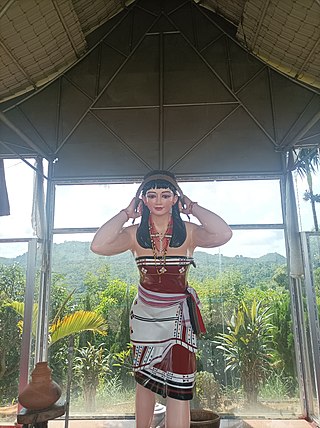Moirangthem Kirti Singh | |
|---|---|
| Born | 1 February 1943 |
| Nationality | Indian |
| Occupation(s) | Writer Educationist |
| Known for | |
| Parent | M. Borajao Singh |
| Awards | Padma Shri Jyotish Ratna (1978), Gavashana Archarya Bharat Excellence Award The Rising Personalities Award Glory of India Award Secular India Harmony Award Netaji Subhas Chandra Bose National Award (2002) |
Moirangthem Kirti Singh is an Indian writer, scholar and educationist from Manipur. [1] Born on 1 February 1943 at Kongba Uchekon near Imphal to M. Borajao Singh, Singh completed his education from Johnstone Higher Secondary School, Imphal and D. M. College, which were under Guwahati University during those days, securing a BA (Honours) and MA in philosophy. [1] Later, he obtained a bachelor's degree in Law (LLB) from LMS Law College, Imphal in 1965, followed by a doctoral degree (PhD) in 1972, making him one of the first Meitei to be awarded a PhD. He is also the first Meitei to receive a DLitt. [1] He served various colleges in Manipur as a member of faculty and has also been involved in social activism. [1]
Singh has published several books on Meitei culture and history, [2] [3] especially on Meiteilogy. [4] Religious Developments in Manipur in the 18th and 19th Centuries, [5] Religion and Culture of Manipur, [6] Folk culture of Manipur, [7] Recent Researches in Oriental and Indological Studies: Including Meiteilogy [8] The philosophy and Religion, [9] and The philosophy of Organism [10] are some of his notable works. His selected writings were compiled and brought out as a felicitation volume by Akansha Publishing House in 2014. [11] The Government of India awarded him the fourth highest civilian honour of the Padma Shri in 1992. [12] Singh, a fellow of the Manipur State Kala Akademi and the Asiatic Society, Kolkata, is also a recipient of awards such as Jyotish Ratna (1978), Gavashana Archarya (1989), Bharat Excellence Award (1998), The Rising Personalities Award (1999), Glory of India Award (2000) Secular India Harmony Award (2002) and Netaji Subhas Chandra Bose National Award (2002). [1]

Chinglen Nongdrenkhomba (1788–1834), also known as Raja Gambhir Singh, was a ruler of the Manipur Kingdom.

Sidaba Mapu or Salailel is the Supreme god, creator of Universe and the Sky God in Sanamahism, the indigenous religion of Manipur. According to Meitei mythology, Sidaba Mapu, being the Creator of the Universe, from a philosophical theory known as Leithak Leikharol Nongsemlon and Leisemlon.
Ningthoukhongjam Khelchandra Singh was an Indian writer, lexicographer and historian, known as the author of Manipuri to Manipuri and English, the first modern general dictionary in Meitei language, which was published in 1964. He was a fellow of the Sahitya Akademi and Sangeet Natak Akademi. The Government of India awarded him the fourth highest civilian honour of Padma Shri in 1987.

Nongshaba is a lion god in Sanamahism and Meitei mythology. He is also regarded as a king of the gods. He is credited with producing light in the primordial universe and is regarded as the maker of the sun. He is worshipped by the people of both the Ningthouja clans as well as the Moirang clans. Nongshaba was worshipped by the people of Moirang clan as a lineage deity and regarded as the father of the god Thangching. He is the greatest of the Umang Lais but he made his only son Thangching the chief deity of Moirang.

Imoinu Iratpa or Emoinu Iratpa or Wakching Taranithoini Pānba is a religious festival celebrated by the Meitei people. It is a festival of lights dedicated to the goddess of wealth and prosperity, Imoinu Ahongbi. The festival is celebrated on the twelfth lunar day of Wakching month of Meitei calendar. The festival is celebrated in Manipur, Assam and Tripura states in North Eastern India and observed by some in the neighboring Myanmar. The festival involves sacrifices and prayers to the goddess, followed by various other cultural events.

Haoreima or Haoleima is a goddess of tragic love and separation in Meitei mythology and Sanamahism, the indigenous religion of Manipur.> According to some legends, she was a woman from the hills, who was killed while arranging to meet her lover, and turned into a tortured spirit. She is regarded as an incarnation of Goddess Panthoibi. She is also identified with the goddess Nongthang Leima.

Noinu Thumleima or Thumkhong Lairembi is the Meitei goddess of salt.

Yumjao Leima or Yumjao Lairembi or Yumjao Lairemma is the mother goddess of house, household, royalty, rule and power in Meitei mythology and religion. She is designated as the all time ruling Queen Mother. Legend says she assumes a human form in white clothes and blesses kings. She is one of the divine incarnations of Leimarel Sidabi.

Laikhurembi is a goddess in Sanamahism, the indigenous religion of Manipur. She is the goddess of justice, good counsel, divine law, order and secrecy. She is the chief Queen of God Thongaren . She is the daughter of Lairen Humchouba. She is one of the divine incarnations of Leimarel Sidabi. She is one of the most important Umang Lais. Her pantheon is maintained particularly by the Taibungjam clan of Meitei ethnicity.

Panam Ningthou is a God in Sanamahism, the indigenous religion of Manipur. He is the protector of crops, especially rice, from hailstorms and thunder. According to legends, He ignited the first fire with flint. He is one of the Umang Lai deities.

A Helloi or Heloi is a female nature spirit in Meitei mythology, folklore and religion. Hellois are often depicted in the forms of beautiful young women. They are often associated with seduction of men. They are the most powerful among the female spirits. They can cause diseases. The hellois are often known for their charming beauty, ecological balance and seduction of males. Hellois are sometimes seen as evil spirits in the forms of beautiful maidens.
Meitei mythology is a collection of myths, belonging to the religious and cultural traditions of the Meitei people, the predominant ethnic group of Manipur. It is associated with traditional Meitei religion of Sanamahism. Meitei myths explain various natural phenomena, how human civilization developed, and the reasons of many events.

Marjing is the God of horses, polo, hockey, sports and war in Sanamahism, the indigenous religion of Manipur. The guardianship of the north eastern direction is alluded to Marjing and the other directions to Koupalu, Thangching and Wangpulen. According to the legend, he invented the game of polo and introduced it as the national game. He and his divine creature, Samadon Ayangba, reside in the top of the Heingang Ching.

Nongda Lairen Pakhangba, was the first Meitei monarch of the Ningthouja dynasty, who ascended the throne of the Kangla of Kangleipak realm) in 33 AD, after the withdrawal of the mainstream powers of the Khabas. Before the reign of king Nongda Lairen Pakhangba, the clans, or salais were already in existence.

The Naoriya Phulo script, also known as the Naoria script, the Invented Meitei Yelhou Mayek script, or the Invented Meetei Yelhou Mayek script, is a constructed script, invented by Laininghan Naoriya Phulo (1888-1941), to write Meitei language. It is different from the Meitei Mayek, the official script for Meitei language. It shares many similarities with the Devanagari script and the Eastern Nagari script.

A Hingchabi is a mythical creature in Meitei mythology, folklore and religion (Sanamahism) of Antique Kangleipak. She has characters similar to those of the vampires as well as the witches. The terms, "hing" means "raw" and "chaa" means "to eat" in Meitei language.
The Ougri Hangen or the Ougri Hangken is a Meitei cultural ritual song with various appellations of the sun and the mythology of creation. It is often sung in the conclusion of the Lai Haraoba festival. Its theme is closely associated with the creation myth of the earth itself. It is also regarded as the song of thanksgiving to the Almighty God. It is always sung in the chorus formed by the male singers with the maiba as the precentor and is strongly enjoined that the chains of the singers forming a circle should never be snapped. It is also known for its incantatory power, for with the alteration of a few lines, it is believed to have been able to cause either prosperity or destruction of the kingdom and the people.
Meidingu Sameirang was a Meetei ruler of Ningthouja dynasty of Ancient Manipur. He is the successor of Naophangba and the predecessor of Ura Konthouba. He was born to King Naophangba of Ningthouja dynasty and Queen Kaireima, the princess of Khuman dynasty. In 518 AD, he defeated Kwakpa Thawanthaba, the chief of the Angom principality and took possession of his territory after killing him.

Mangang Luwang Khuman is the triple deity of supreme divinity in Sanamahism, the Meitei religion. The three deities are Mangang Sitapa, Luwang Sitapa and Khuman Sitapa. They are also regarded as the progenitors of the Mangang dynasty, the Luwang dynasty and the Khuman dynasty, the three of the seven ruling clan dynasties of Antique Kangleipak.
Yairipok Thambalnu, originally known as Sanoujam Chanu Thambalnu or simply as Thambalnu, was a Meitei lady native to Yairipok region of Kangleipak. She was a victim of intrigues and was forced to meet a tragic death in drowning in a flooding river.